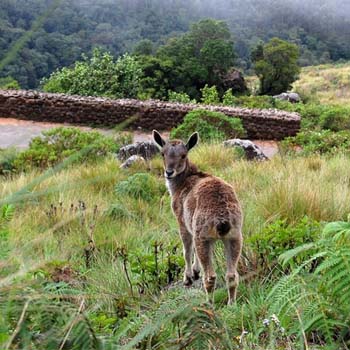Discover Eravikulam National Park: A Sanctuary for Nilgiri Tahr and Natural Beauty in Kerala

Location and Establishment:
Eravikulam Wildlife Sanctuary, situated in the Devikulam taluk of Idukki district, Kerala, emerged as a wildlife sanctuary in 1975. By 1978, it achieved national park status. The sanctuary spans roughly 97 square kilometers and lies approximately 15 kilometers north of Munnar.
Flora and Fauna:
The park is particularly noted for its population of the endangered Nilgiri Tahr, a mountain goat unique to South India. The landscape showcases rolling hills, grassy knolls, and Shola forests. It hosts various native flora, including the rare Neelakurinji plant that blooms once every twelve years.
Prominent Features:
Anaimudi, the highest peak in South India, resides within the park. This peak stands at an elevation of 2,694 meters. The name "Anaimudi" translates to "tuft of an elephant," aptly describing its resemblance to an elephant's head.
Climate:
Eravikulam enjoys a favorable climate throughout the year. The monsoon seasons bring heavy rainfall while winters can be frosty. Such conditions make it ideal for touring & wildlife observation.
Wildlife:
Visitors to Eravikulam can observe a diverse range of wildlife. Over a thousand Nilgiri Tahrs inhabit the area alongside tigers, leopards, jungle cats, civet cats, wild boar and sloth bears. Additionally, Nilgiri Langurs, squirrels, mongooses & various reptiles also reside here. The sanctuary is home to numerous butterfly and moth species as well—among them the Atlas Moth, one of the largest in the world.
FAQs
What makes Eravikulam National Park unique?
Eravikulam National Park is renowned for its population of endangered Nilgiri Tahr and its beautiful landscape of rolling hills and Shola forests.
How can I reach Eravikulam National Park?
The park is located 15 km north of Munnar in Kerala, and it can be accessed by road from major cities in the region.
What is the best time to visit Eravikulam National Park?
The best time to visit is during the winter months (December to February) when the weather is cool and ideal for wildlife observation.
What wildlife can be seen in Eravikulam National Park?
Visitors can spot Nilgiri Tahr, tigers, leopards, jungle cats, wild boar, sloth bears, Nilgiri Langurs, and various reptiles, along with numerous butterfly and moth species.
What is the significance of the Neelakurinji plant in Eravikulam National Park?
The Neelakurinji plant is a rare species that blooms once every twelve years, giving the Nilgiri Hills their distinctive blue color.